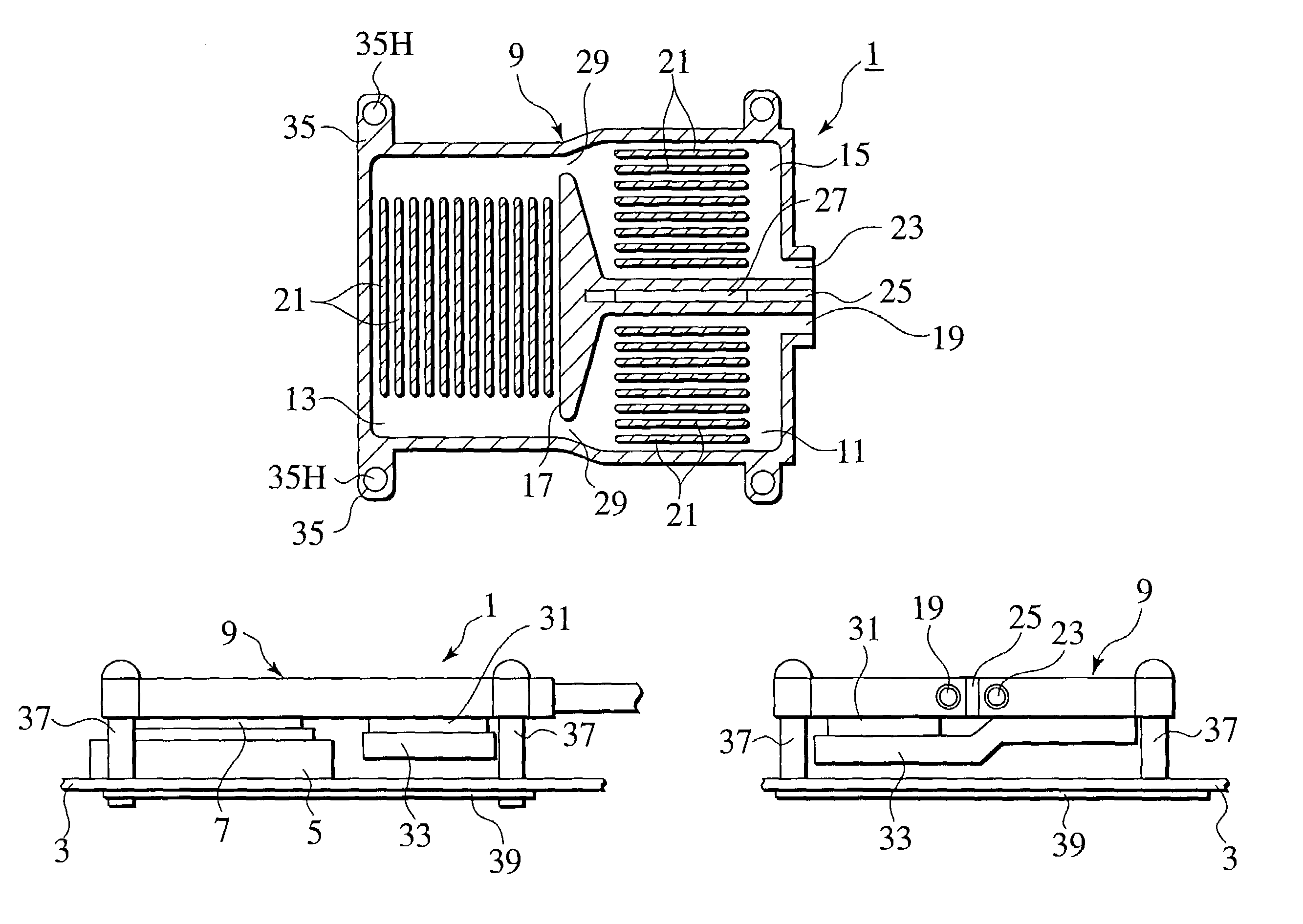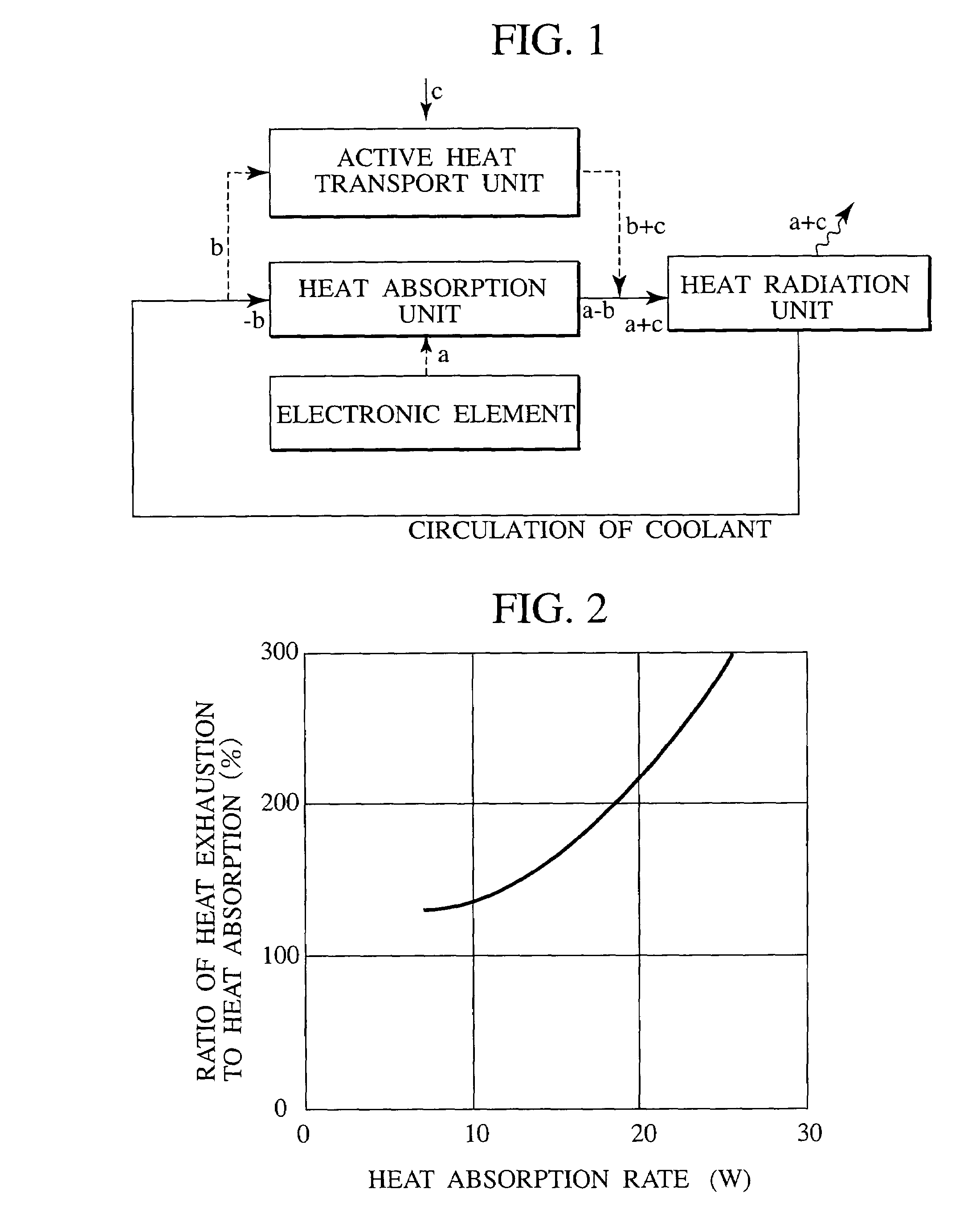Cooling device for electronic element producing concentrated heat and electronic device
a technology of electronic elements and cooling devices, which is applied in the direction of electrical equipment, lighting and heating equipment, and domestic cooling equipment, etc., can solve the problems of cpu malfunction, affecting the operation temperature affecting the efficiency of the cooling system, so as to achieve more effective heat radiation
- Summary
- Abstract
- Description
- Claims
- Application Information
AI Technical Summary
Benefits of technology
Problems solved by technology
Method used
Image
Examples
first embodiment
[0033]the present invention will be described hereinafter with reference to FIGS. 3A–3C. In the following description, a CPU 7 is exemplified as an electronic element and a Peltier element 31 is exemplified as an active heat transport unit, however, the present invention may be enabled with any proper elements or devices other than the CPU 7 and the Peltier element 31.
[0034]A cooling device 1 according to the first embodiment is basically composed of a casing 9 which has an inflow port 19 and an outflow port 23 and is made in a watertight manner, the Peltier element 31 and a heat transfer member 33, both of which are connected with a lower side thereof. The cooling device 1 is installed to a substrate 3 of an electronic device so as to be thermally connected with the CPU 7 electrically connected with a socket 5 on the substrate 3.
[0035]Inside of the casing 9, as the sectional view thereof shown in FIG. 3A, an element cooling chamber 13, a coolant cooling chamber 11 and a coolant hea...
second embodiment
[0049]The second embodiment increases a degree of a design freedom of an electronic device interior because the element cooling chamber can be disposed independently of the coolant cooling chamber 11 and the coolant heating chamber 15.
[0050]A third embodiment of the present invention will be described hereinafter with reference to FIGS. 5A and 5B. Rear surfaces of the coolant cooling chamber 11 and the coolant heating chamber 15 are directed with each other and the Peltier element 31 is put therebetween. The heat transfer member 33 bridged between the Peltier element 31 and the coolant heating chamber 15 is omitted in the third embodiment. The third embodiment can be more simply constituted and heat transfer between the Peltier element 31 and the coolant heating chamber 15 comes to be more effective.
[0051]A fourth embodiment will be described hereinafter with reference to FIG. 6. In the fourth embodiment, air is employed to the cooling medium. A fin base 47B provided with a pluralit...
third embodiment
[0054]FIG. 7 is a schematic drawing of a notebook PC 56 as an example of the electronic device to which the cooling device of the second or third embodiment is applied.
[0055]The notebook PC 56 is provided with an element cooling area 67 corresponding to the element cooling chamber. The coolant cooling chamber 11 and the coolant heating chamber 15 are housed in an auxiliary heat radiation unit 69. The auxiliary heat radiation unit 69 is housed in a main chassis 103 of the notebook PC 56 and is connected with a heat radiation unit 41 housed in a sub-chassis 105 via a pipe line 70. The main chassis 103 further houses a pump 43 connected with the pipe line 70 so that a cooling medium circuit is constituted and the cooling medium is circulated therein.
[0056]The element cooling area 67 is provided with an inlet port 67A and an outlet port 67B for the cooling medium and is further provided with a plurality of fins 67C therein as shown in FIG. 8. The element cooling area 67 is thermally con...
PUM
 Login to View More
Login to View More Abstract
Description
Claims
Application Information
 Login to View More
Login to View More - R&D
- Intellectual Property
- Life Sciences
- Materials
- Tech Scout
- Unparalleled Data Quality
- Higher Quality Content
- 60% Fewer Hallucinations
Browse by: Latest US Patents, China's latest patents, Technical Efficacy Thesaurus, Application Domain, Technology Topic, Popular Technical Reports.
© 2025 PatSnap. All rights reserved.Legal|Privacy policy|Modern Slavery Act Transparency Statement|Sitemap|About US| Contact US: help@patsnap.com



